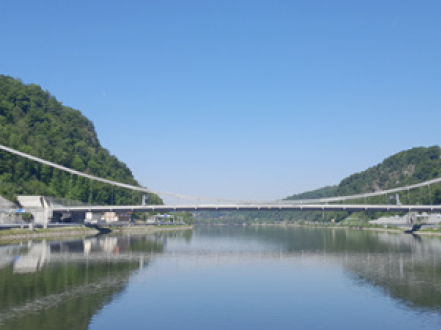A new landmark floating over the Danube
Linz, Austria. The new bridge over the Danube in Linz is an elegant landmark for the capital of the Upper Austria region. One of the many challenges posed by this flexible suspension bridge were the expansion joints. The large rotations of up to ±58 ‰! at the ends of the support structures called for a custommade solution: swivel joist expansion joints from MAURER.
The fifth bridge over the river Danube in Linz is part of the A 26 bypass project, which aims to connect the A 7 motorway with the B 127 on Rohrbacher Strasse. Once complete, the bypass will both reduce traffic in the city centre and shorten journey times for commuters travelling from the west.
Measuring 305.55 m in length and 22.5 m in width, the bridge is the only suspension bridge over the Danube in Austria – and it is a true suspension bridge. The 500-metre-long suspension cables are anchored directly in the rock, while the access and exit ramps are located in tunnels at the north and south ends of the bridge. The bridge is the longest earth-anchored suspension bridge of its kind, and appears to float elegantly over the Danube without any piers.
The superstructure features a composite design consisting of a single-cell steel-box girder with a concrete deck. This keeps the bridge slim and elegant, making it a landmark that is already being praised for its combination of form and function.
Light, flexible, stable
An optically light design generally brings a number of technical challenges, and the bridge in Linz was no exception. The compact conditions on site also made the project tougher for everyone involved. These challenges could only be over- come through detailed planning and solutions, together with intensive teamwork.
MAURER was tasked with one of the most decisive elements: the transition from the bridge into the tunnels. Due to its comparatively light and soft design, the bridge is subject to relatively large movements and rotations at its ends on the north and south banks.
The bridge is connected to the ends by means of expansion joint constructions. These allow for displacements and rotations in the structure, while also absorbing the traffic loads. Displacements usually result from temperature fluctuations in the superstructure, for example. Rotations at the ends of the superstructure can be caused by deflection of the superstructure and/or the cables expanding due to temperature. The specific expansion joints used in Linz are known as swivel joist expansion joints. Unlike other expansion joints, these can allow for displacements in all directions and rotations in all axes.
The swivel joists were designed, built and installed in order to provide a permanent solution to the large rotations of up to ±58 ‰! around the bridge’s lateral axis at both ends of the superstructure.
A pair of noise-insulated expansion joint constructions were fitted in the summer of 2023. Each of these measures around 23 m in length, with a movement capacity of 570 mm (XLS 600) and 665 mm (XLS 700) respectively.
Additional noise reduction
The surface of the expansion joints features special rhomboid plates that reduce the noise of vehicles passing over by 50-60%. In addition, MAURER developed a special insulating system to enclose the underside of the bridge (see cross-section) and further reduce noise emissions significantly. This can be easily opened and closed again at any time for inspections and assessments of the expansion joints from below via the gap in the structure. As a result, the noise level at the expansion joint construction is only slightly higher than that of the normal road surface – an outstanding achievement given the size of the components.
Construction of the new bridge over the Danube began in January 2019. It was approved for use by traffic in November 2024, initially with only one lane in each direction for local traffic. Once the next section of the A 26 is completed in 2028, the bridge will open to traffic on two lanes with hard shoulders.
ASFINAG (Autobahnen- und Schnellstrassen Finanzierungs-AG) is responsible for managing the entire project.


